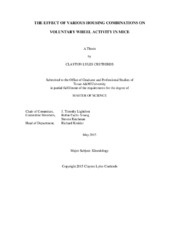| dc.description.abstract | It is widely accepted that mice are active, social animals. Treadmill running, basal cage activity, and voluntary wheel running have all been used in order to study these qualities. Wheel running models have been used as an index of voluntary physical activity and appear to have several correlates in humans. Distances covered and voluntary aspect of many wheel running models allows researchers to study genetic motivators of activity as well as to track responses to training. Often, wheel running models employ a single mouse and wheel per cage, which precludes social interactions and may impact activity levels and other parameters due to anxiety. The mechanisms by which this isolation modifies activity levels are of paramount importance to support accurate translation of results to human application. This study was designed to assess the effects of housing density and wheel availability on activity levels in mice. Six outbred female SENCAR mice (National Cancer Institute, Bethesda, MD) were housed under various conditions by altering the number of animals and exercise wheels per cage. Starting at six weeks of age, mice were given wheel access in one of two cage combinations: one mouse and one wheel (n= 4) or two mice and one wheel (n= 1). Data pertaining to distance and duration ran was recorded daily, with speed being calculated later as the third primary value of interest. Over the study span of 33 weeks the mice were randomly re-assigned to 1 mouse/1 wheel (total 506 days), 2 mice/1 wheel (64 days), and 2 mice/2 wheel (316 days) combinations (1v1, 2v1, and 2v2 respectively). While data was collected for all combinations, 1v1 and 2v2 were maintained for the longest amount of time. Overall, the SENCAR mice would be classified as high-active mice. When standardized per mouse, mice ran significantly less distance per day (p=0.0001) when two mice were housed in the cage regardless of the number of wheels (1v1 = 10.01±4.02, 2v1 = 6.19±3.35, 2v2 = 6.27±3.43 km) as well as less time per day (1v1 = 309.8±109.4, 2v1=186.1±94.5, 2v2=157.4±65.9 mins; p=0.0001). Conversely, speed of activity was significantly faster (p=0.0001) in the 2v2 housing situation (1v1=32.1±5.9, 2v1=33.38±7.0, 2v2=38.4±9.6 m/min). In summary, housing density and wheel availability can alter activity levels in SENCAR mice. | en |


